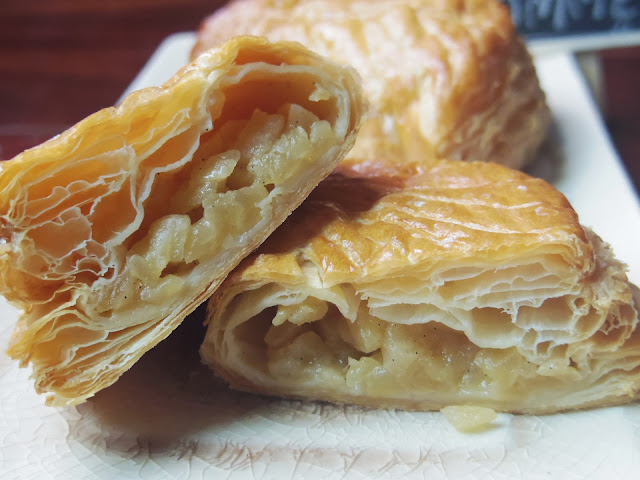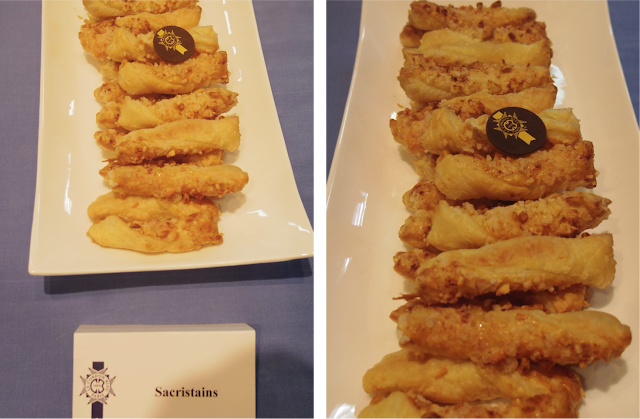For the first time on my blog, I've compiled one week (3 practicals) worth of lessons into one blog posts; reason being, it's all on Feuilletage, a.k.a puff pastry.
The making of puff pastry is labelled in two different sections namely, the détrempe; referring to the main body of the dough, consisting of flour, water and butter etc, and the paton; referring to stage of the dough whereby butter has been incorporated during the 'turns' or, folding of the dough to create the layers.
When 'folding' or doing the turns for the puff pastry dough, it is important to let rest between each turns, and we can only do a maximum of 4 times of double turn and 6 times of single turns, which will give us 513 layers and 1459 layers respectively. This will result in a more layered puff pastries, crispier and flakier.
I'm going to keep my post short and sweet, other wise there will be too many words and I will just briefly run through some of the pastries Chef Marc had demonstrated.
On Tuesday, Chef Marc went through the makings of Palmiers, Vol-Au-Vent Mignardises and Fruit Mille Feuille.
Here, we have the palmiers, a leaf shaped crunchy puff pastry, which opens up when baking and form a heart-like shape or, like a butterfly. When rolling out the dough, we fleur the worktop with sugar, instead of flour and roll the dough to get coated and spread out as much as they could, with the sugar. After that, we roll it by 3, and cut 1.5cm per each piece.
My class made a mistake during the paton stage; we had received the wrong amount of butter from the school's kitchen, and on our part, we forgot to verify the butter's quantity and just incorporated it into our puff pastry dough.
Find out what happen, later in my post.
Then, we have the vol-au-vent mignardises. Think, little puffs filled with cream mushrooms, like the ones we get served during cocktails or some of the buffet spreads. These little petit fours as mignardises are also known as; are piped with pastry creams and served with fruits.
I particularly like the middle one, which is with pineapple and lime zest. The lime zest provides a very nice, refreshing kick.
The fruit mille feuille is also filled with pastry creams and fresh fruits, nothing much interesting, besides for the fact that it was baked together with stands in order to curb the expansion of the puff pastry. This will allow the puff to have a nice equal height, rather than one part higher and the other part lopsided.
Check out my palmiers!
It doesn't spread much as compared to Chef Marc's palmiers because of the different amount of butter being used.
For our puff pastry, we are not using pure butter in the Basic level, but instead, uses a special type of butter mixed with margarine. The 'butter' we used during the turns is even lesser than the minimum level of butter puff pastry is supposed to have, hence the product doesn't turned out nicely.
I'm sure that would affect our grades in one way or another, but as the only class where most of the students had this result, Chef Marc had his assistants prepare a new batch for our upcoming practical.
Moving on, Chef Marc did the demonstration on chausson aux pommes, tarte tatin and galette de rois on Wednesday.
There's the regular sized ones on the left and mini ones on the right hand side. These chausson aux pommes a.k.a apple turnovers were delish!
It sure is a lot of work, but worth every bite! We had to first cut out the shape with a 12cm cookie cutter with razor edge, then roll the dough out to 18cm length, cook the apple compote, this time with leaving it as diced apples for extra crunch instead of blending it like baby food. Then fold it, cup the fillings with another cookie cutter, press a little and turn the puffs, before applying two layers of egg wash and rayer it (using knife to make patterns).
Here, we have the tarte tatin; a caramelised apple compressed dessert with a puff pastry bottom. It was created by accident by two sisters, Stephanie and Caroline Tatin, who runs the Hotel Tatin in France, somewhere in the south of Paris in the 1880s.
According to Chef Marc, he said that there's many stories regarding the real story of this tarte, but the most common story was that one of the sisters was cooking the apples to make an apple tart, but had left the stove for too long till the apples were caramlised in the saucepan, and in an effort to save the compote, she cut out the puff pastry and put it on top of the pan, covering the apples, before throwing it into the oven to cook the pastry.
After overturning the tarte, she served it up to her customers, whom, to her credit and surprise, loved the tarte so much, and since then, a classic dessert has been born.
During food tasting, I was really enjoying this tarte tartin! It has one of the best flavors combined together, sweet, sour and really crispy.
Last recipe for the day, we have the Galette Des Rois a.k.a King Cake, which is a extremely popular cake during the Christmas season in France, Belgium, Switzerland, just to name a few as a celebration cake.
Chef Marc shared that the galette has a hidden small trinket, which allows the person who gets the cake, to be a 'king' or queen' and they have various privileges and obligations to fulfill. Sometimes the bakery will come out with their own variations or collections of the trinkets, prompting customers to frequent the shops more often in order to complete the collection. Though the traditional trinket is often a small plastic baby, said to represent Baby Jesus, some bakeries even went to the extend of putting in diamonds!
Talk about McDonald's and their Hello Kitty gimmick; the people in France has long thought of collections yo!
Moving on, I'm pleased to share with you - one of my most delightful baked products ever!!
Chausson Aux pommes!! I'm majorly proud of myself on this one! It's all of equal sizes, filled with wonderful buttery apple caramelised apple compote, lightly brushed with two layers of egg wash to give its golden brown colour and a light coating of base syrup after baking to give its shine.
This apple turnovers is the bomb! It's crisp and flaky with every bite, warm apple compote in every mouthful, delicious to the very last flake!
Maybe it's just me? But..I really, really adore these flaky layers by layers!
Then, for the final demo on puff pastry for the week, Chef Marc did the demonstration on Sacristains, Grillé aux pommes., Mille-Feuille Alascian, flan pâtissier, Bandes Aux Pommes and Bandes Aux Abricot.
The difference to the puff pastries we're making today, is that most of the mentioned pastries does not required freshly made feuilletage dough, rather, it can be made using the dough's trimmings.
First up, we have the Sacristains; which is something like twisted bread sticks but made out of puff pastry and is sprinkled with almonds and nib sugars before baking. I would love to make this with cheese and bacon when I'm back home, like those of which restaurants would served up in a tall glass as starters.
For this pastry, however, it is best made using freshly made puff pastry dough.
Next, we have the grilles aux pommes; a thin puff pastry with blended apple compote and covered with cut out pastry, before being glazed with neutral glaze to give it its shine.
Moving on, we have the flan pâtissier, which is also known as the custard tart, made with puff pastry trimmings and pastry cream with the cream powder, and lightly brushed with egg wash to give it a nice browning top.
I get to bake this during practical.
Chef Marc also showed us how to do Bande aux pommes, which consists of a 12cm length base with two strips of 2cm, piped with almond cream and topped with thin slices of half an apple and finally glazed with apricot glaze to give shine and for conservation.
Last but not least for the day, was this - Bande aux abricots; done the same way as the apples, but with rows of apricot.
Proud to present to you, my Bande Aux Abricots!
Made with trimmings, and piped with almond cream before being topped with rows of apricots, it's like an open faced danish fruit tart.
I sure enjoy a slice or two!
Then, last but not least, we have my flan pâtissier!
Check out the creamy custard peeking out, and the little black specks of vanilla pod on the surface. The tart was lightly brushed with egg wash before baking, so it has a good brown colour in some areas only - you can get it slightly darker by baking it a little longer.
I somehow find that it looks like a giant egg tart though, HAHA!
I would totally go for a second slice, except, I didn't. Because when you're the one baking, and tasting, you've got to be really, really careful with what you're really eating.
I sure don't wish to get as round as the flan pâtissier!
With that, I wrap up my long week of puff pastry!
It's been good to know how to make a good puff pastry, and I look forward to conquering the world of puff pastries in near future. Meanwhile, I'll have to practice more on my rolling, and my crimping for the upcoming exam, where we all need to do a good tart presentation like the apple tart, and also, to practice piping.
There's a few cakes on the exam list, and I've noted that we have one or two cakes coming up next week.
Ooh! And there's chocolate to be tempered too!! Can't wait!
Till then!






















No comments:
Post a Comment